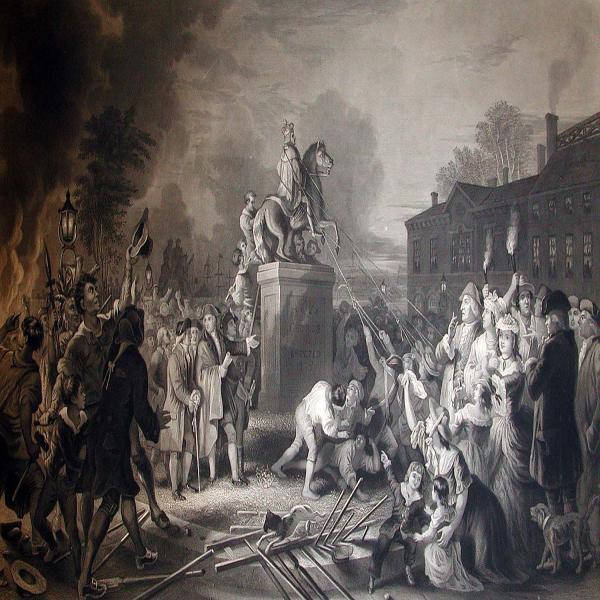Pulling Down the Statue of George III
Original

Background Notes
Artist: John C. McRae was an engraver and printer in New York City (1) who based this engraving off of a painting by Johannes Adam Simon Oertel (1823-1909). Oertel was a painter and engraver who emigrated from Germany in 1848. He is known for his religious paintings and for his ceiling decorations at the House of Representatives in Washington. (2)
On July 9, 1776, the Declaration of Independence was read for the first time in New York in front of George Washington and his troops. In reaction to what had been read, soldiers and citizens went to Bowling Green, a park in Manhattan, where a lead statue of King George III on horseback stood. The mob of people pulled down the statue, and later the lead was melted down to make musket balls, or bullets for use in the war for independence. (3) Careful records were kept, and it is known that 42, 088 bullets were made. (4)
This engraving, and the painting that it is based upon, show a very romanticized version of the event. According to the eye witness accounts, the mob included soldiers, sailors, blacks, and a few lower class citizens, not the women, children, and Native Americans pictured here. Also, the artist portrays King George’s statue incorrectly. The statue in the image is wearing eighteenth century clothing and a crown. (5) No image exists of the actual statue, but descriptions of it mention that it was sculpted wearing a Roman toga. All that is left of the statue are a few fragments that broke off when it fell to the ground. The statue only stood erect in Bowling Green for six years, as it was originally commissioned to celebrate the repeal of the Stamp Act in 1766. (6)
This incident was symbolic because it showed that Americans were ready to be independent and free from tyrannical rule, but also by pulling down a statue of the King, it was a symbolic gesture to make historic change from the rule of a monarchy to the rule of a democracy. (7)
(1) Groce, George C. and David H. Wallace, The New York Historical Society’s Dictionary of Artists in America, 1564-1860 (New Haven: Yale University Press, 1957), 418.
(2) Groce, 476.
(3) A City Nearly Abandoned: Independence & its Enemies in New York, http://independence.nyhistory.org
(4) Marks, Arthur S. “The Statue of King George III in New York and the Iconology of Regicide,” The American Art Journal 13 (Summer 1981): 62.
(5) A City Nearly Abandoned.
(6)Marks, 61-62.
(7) Marks, 66-67.